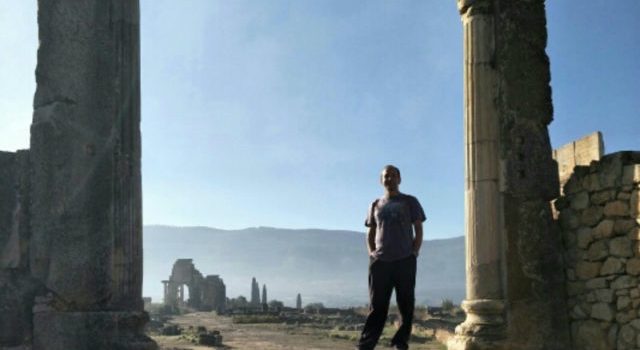Morocco’s songs of Jewish past
It’s difficult enough to imagine that I had a religious experience in a country where only a handful of Jews remain. It’s all the more amazing that it occurred in a sacred pilgrimage village that was once forbidden to non-Muslims. Moulay Idriss is where the faithful gather at the tomb of the great-grandson of Muhammad, who brought Islam to Morocco.
I travelled to the town from the ancient city of Volubilis, which was once a provincial Roman capital and is an undeniably impressive site. Among the incredibly preserved remains (to call them “ruins” would be doing them a disservice) were parts of a synagogue and plots of land that belonged to an active Jewish community. Here, as in many places in this area back in the day, the three major religions lived harmoniously – if not best friends, then at least peaceful cohabitants.
This became even more apparent as I continued to tour Morocco. In every city or village I visited, signs of a once-vibrant Jewish quarter (mellah in Arabic) were not just evident, but prominent: street signs named after rabbis; plaques indicating where synagogues once stood; and locked gates protecting ancient Jewish cemeteries.
As excited and proud as I was to see these markers, it was also somewhat troubling and depressing. For as much as Jews were once treated with respect and dignity in these towns (mellahs were purposefully built near the royal palace, as the ruler of the day wanted the Jews close by for their business acumen and wise counsel), there are no longer any signs of active Jewish life as far as I could tell.
This was especially evident as I came across the gate to the Jewish cemetery in Fes – the country’s second-largest city, which is often referred to as Morocco’s cultural capital. Coercing my way inside (after a monetary show of appreciation to an old woman passing by who somehow had a key), I explored hundreds of whitewashed tombs, until I came upon a building with a locked door. A few more coins changed hands and an even older man carrying a huge set of keys miraculously appeared and led me to a sight that left me speechless.
I was standing inside one of the most beautiful, ornate shuls I have ever seen. It was decorated from floor to ceiling with mosaic tiles, hand-carved wooden accents and elaborate hanging lamps. But all of this – along with the Aron Kodesh and bimah – were almost impossible to see through the clutter that filled every inch of space. It was like a huge Jewish junk shop (flea market, if I’m being kind). Everything from dusty tefillin to old kosher butcher signs, discarded sheitels and paintings of revered rabbis (along with a facsimile of the Mona Lisa right next to an ark containing the lone, shabby Torah scroll). Remnants of hundreds of years of vibrant Jewish life had been thrown into what the old man now called “the museum.”
This all came back to me on my pre-Shabbat trek through the hills of Moulay Idriss. As I stopped to catch my breath, below me, I saw the village’s picture-perfect medina. And then it started – a low, mournful wail that cut through the silence not like a dagger, but like a butter knife spreading an aural layer on the picture painted below. At that moment, the muezzin’s call to prayer – which is directed toward Allah, in Arabic – could just as easily have been the Shema, directed toward ha-Shem. It was an opportunity to stop and reflect upon the beauty surrounding me, and to thank my creator for all that had led me there. The chills began. It was a Kabbalat Shabbat like no other.
This experience – which seemed to last for hours, but was no more than minutes – shook me to my core and brought to a head what I had been feeling throughout my Moroccan adventure. The similarities and shared practices between Arabic and Jewish cultures were evident everywhere: the hamsa to ward off evil; the families sitting on low stools during the seven-day grieving period after the death of a loved one; the accepted behaviour (or lack thereof) in a shuk; the food; the music. Even Arabic words were easily understandable to my Hebraic ears. For example, the aforementioned “mellah” was thusly named because the Jewish merchants dealt in salt- “melach”).
I felt more of a kinship with the citizens of Morocco than with most North Americans I have encountered throughout my travels in the U.S. and Canada. The more time I spend in the Arab world (having visited Egypt and Jordan, as well), the more ludicrous our conflicts appear. At the risk of oversimplifying – and condensing centuries of terror, hatred and bloodshed into what might be perceived as a naive statement – there is no doubt in my mind that our struggles and battles over the years have been between family, not strangers. (With plenty of black sheep on both sides to ensure that true familial harmony will never prevail.)
But standing on that Moroccan hilltop gave me a renewed sense of hope. As the song goes, Kol ha’olam kulo, gesher tsar me’od – the whole world is a very narrow bridge. I can only pray that we all cross it together, safely and peacefully.

